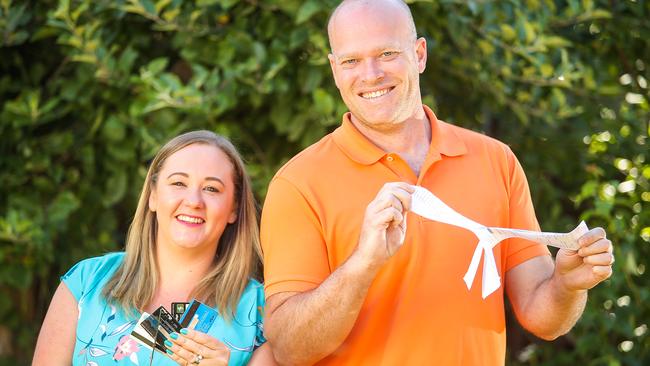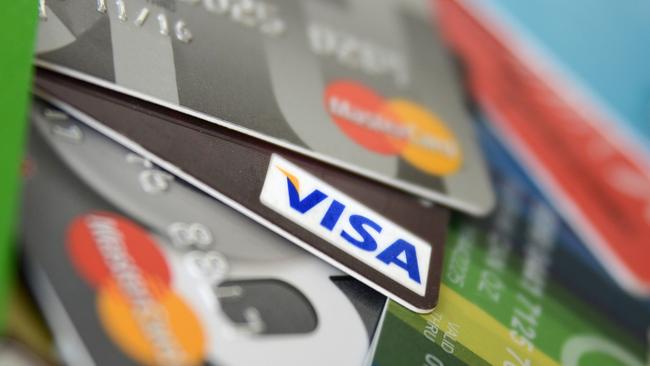The fastest ways to reduce your credit card debt in 2019
Millions of Australians are trapped in a debt dungeon. We’ve asked the experts for the fastest ways to cull your card debt and get back in the black.
Saver HQ
Don't miss out on the headlines from Saver HQ. Followed categories will be added to My News.
Millions of Australians are trapped in a debt dungeon as they enter the new year laden with credit card woes.
Exorbitant interest rates of more than 20 per cent can sting customers if they fail to pay card off their card debt in full each month.
Latest Reserve Bank of Australia statistics show in November Australians were swimming in $52 billion in card debt and a massive $31.5 billion is accruing interest charges.
And for many cash-strapped consumers they are likely to be already dealing with a Christmas debt hangover.
Credit card statements are due to arrive any day now from the Christmas and new year period. And for those who shopped up a storm they’ll get a rude shock once they are faced with a whopping bill.
All eyes have been on the banks in recent months in light of the financial services Royal Commission and this has forced them to pull up their socks and behave more responsibly.
Consequently dishing out credit has become more tougher, so for consumers seeking credit cards in 2019 you might find you’ll get knocked back.
Here are some handy ways to kill that credit card debt in 2019.
MORE: Why you’re richer than you think
MORE: Best home loan rate deals in 2019
MORE: Why it’ll be harder to get a credit card in 2019

PULL OUR YOUR CARDS
There are more than 15.9 million credit cards in circulation so there’s a good chance you have more than one card.
Gather your credit card, or cards, and latest statements so you can review the balances owing.
Zoom in on the fees and charges you are paying, many cards come with annual fees and high interest rates which do hit hard.
Looking at these bills might give you the wake up call you need to highlight how much money you are shelling out unnecessarily.
There are plenty of cards on the market that have no annual fee so it’s a charge that can be easily avoided.
As for interest rates while many are over 20 per cent there’s multiple lenders who offer single-digit interest rates.
This is critical for those cardholders who are unable to pay off their card in full each month.
Mother-of-two Kylie Don, 36, has a credit card with a $1000 limit and her husband Richard, 38, also has a card with a $3000 limit.
“We use my husband’s card to pay rent and bills and it’s maxed out at the moment,” she said.
“But we are doing our best to get through it all.
“I put money towards me paying off my credit card each pay cheque.”
Mrs Don said when they have a small windfall at tax return time any money received is quickly swallowed up trying to wipe their plastic debts.
Like many Australians, Ms Don said she feels like she is caught in revolving debt.
She is hoping to wipe the slate keen by paying off her card debt this year and finally shutting down her account.

STOP USING YOUR CARD
The fastest way to killing off your debt is putting a stop to using your card altogether.
This might seem harder than it is but an easy step is to remove all the bills and expenses automatically being charged to your credit card.
Instead shift direct debits across to your daily transaction account.
Tribeca Financial’s chief executive officer Ryan Watson has urged people to “ditch their credit cards” in the new year.
“If you simply must have a credit card in case of emergencies you should have a limit of $1500 and only use it in the case of emergencies,” he said.
“They shouldn’t be used at all for discretionary spending.”
Mr Watson said he recently had a client who amassed $55,000 of credit card and personal debt over a number of years thanks to splurging on holidays and shopping.
He warned that cards simply encourage “the purchaser to spend beyond their means.”
Also remove any card details they are saved in shopping websites so it’s tougher to spend up without giving it much thought.

PLAN OF ATTACK
Once you have a clear picture of your credit situation work out how you can realistically cull your card debt.
This involves giving yourself a set timeline on how to wipe the debt and then making it happen.
For instance, if you owe $10,000 on a credit card and want to wipe the debt in a year, calculate what you need to put towards it each pay cheque to get rid of it.
Financial comparison website finder.com.au’s spokeswoman Bessie Hassan a good option to consider is a balance-transfer card.
“A balance transfer can provide peace of mind and some breathing space when combining it with a repayment plan,” she said.
“Once your transfer is approved close the old card so you don’t end up with two piles of debt.”
Balance-transfer cards allow customers to move their card debt from one card to another and revel in a zero per cent honeymoon period.

It gives customers a set amount of time to pay off their debt without accruing any interest charges.
But be warned, if you make any purchases on the new card interest will be charged on those transactions.
So the best thing balance-transfer card customers can do is never use their card once they receive.
This allows determined customers to maximise the ability to wipe the slate clean once and for all.
Some financial institutions offer balance-transfer periods of up to 26 months but there are often fees attached.
This is usually up to 3 per cent of the balance transferred over.
BankVic’s spokeswoman Natalie Pennisi also suggests customers start by tackling the cards owing the least amount of debt on them.
“You have multiple credit cards, pay off the one with the smallest balance first,” he said.
“Achieving one small goal may help inspire you to tackle other debts.”
And she said another good approach is to smash the debt by always paying more than the minimum amount required.
Often credit providers only require customers to pay a minimum two per cent of the balance each month which can leave customers revolving in debt they never pay off.
CREDIT CARD CHANGES
Multiple changes kicked on in on January 1, which will make it harder for customers trying to get a new credit card.
Lenders must now follow stricter rules which include zooming in more closely on a customer’s serviceability levels.
The changes kicked in on January 1 and are designed to stop inappropriate lending.
They include:
• Credit providers must give customers the ability to cancel or reduce credit limits online.
• Banks cannot back date interest charges on credit card balances.
• Card issuers cannot contact customers to offer credit limit increases.

Ms Hassan said for customers seeking a card to request a lower limit.
“If you currently have a card with a credit limit that you could not pay off in three years, it might be a good idea to request a lower limit before you apply for a new card,” she said.
“This change is a big step in the right direction when it comes to cutting down on serious credit card debt.”
But the new rules are a bit flimsy.
Once the cardholder has the new card the bank does not have to force them to pay back the debt within a three-year period.

REWARDS CARDS
While many customers get lured into signing up to credit cards to accrue reward points sometimes customers can be wasting their time and money.
Banks have been forced to significantly reduce the value of their rewards points schemes because of the scaling back of interchange fee regulations in 2017.
This is the amount merchants charge for accepting plastic and they were previously serious money spinners for lenders.
Mr Watson said rewards points for many shoppers are simply a trap.
“Bonus points on your credit are basically only used as an inducement to encourage excess spending, not to genuinely reward the spender,” he said.
He said customers often puts their everyday spending on a credit card and were left to pick up the pieces and pay off the debt at the end of the month.
Analysis by financial website RateCity found on some cards customers need to spend more than $50,000 on a rewards card just to get a $129 toaster in return.
STICK TO PAYING WITH CASH
Once you’ve cut through your credit card debt start a new approach to paying for goods.
Ms Pennisi said “cash is still king”.
“If you don’t have the cash, don’t buy it until you do,” she said.
“Save for the things you really want.”
Shoppers should also turn to only using a debit card because as Ms Pennisi said, “it’s a lot harder to overspend when you know it’s your own money.”
How to slash credit card debt in 2019
— Get a copy of your latest credit card(s) statement.
— Look at the fees and charges on your account.
— Stop using your credit card.
— Work out a plan to get rid of your debt.
— Lower your credit card limits.
— Consider transferring to a balance-transfer card.
— Once your cards are paid off shut down your accounts.
— If you need help contact your credit provider or the National Debt Helpline on 1800 007 007.

Best no annual fee credit cards
1. Bankwest Zero Platinum Mastercard: 17.99 per cent, up to 55 days interest free on purchases, no foreign transaction fees.
2. 28 Degrees Platinum Mastercard: 21.99 per cent, up to 55 days interest free on purchases, no foreign currency conversion fees.
3. ING Orange One Visa: 11.99 per cent, up to 45 days interest free on purchases.
Source: Finder.com.au.
Best balance-transfer credit cards
1. Westpac Low Rate Card, 13.49 per cent, up to 55 days interest free on purchases, $0 annual fee for the first year, then $59 onwards. Balance-transfer offer for 24 months, 1 per cent balance-transfer fee.
2. Bankwest Breeze Mastercard, zero per cent for 6 months then reverts to 12.99 per cent, up to 55 days interest free on purchases, $0 annual fee for the first year then $79 onwards. Balance-transfer offer 26 months, 2 per cent balance-transfer fee.
3. Bank of Melbourne Vertigo Platinum, 12.74 per cent, up to 55 days interest free on purchases, $0 annual fee for the first year then $99 onwards. Balance-transfer offer 26 months, 2 per cent balance-transfer fee.
Source: Finder.com.au
*Scott Pape’s column will return next week


